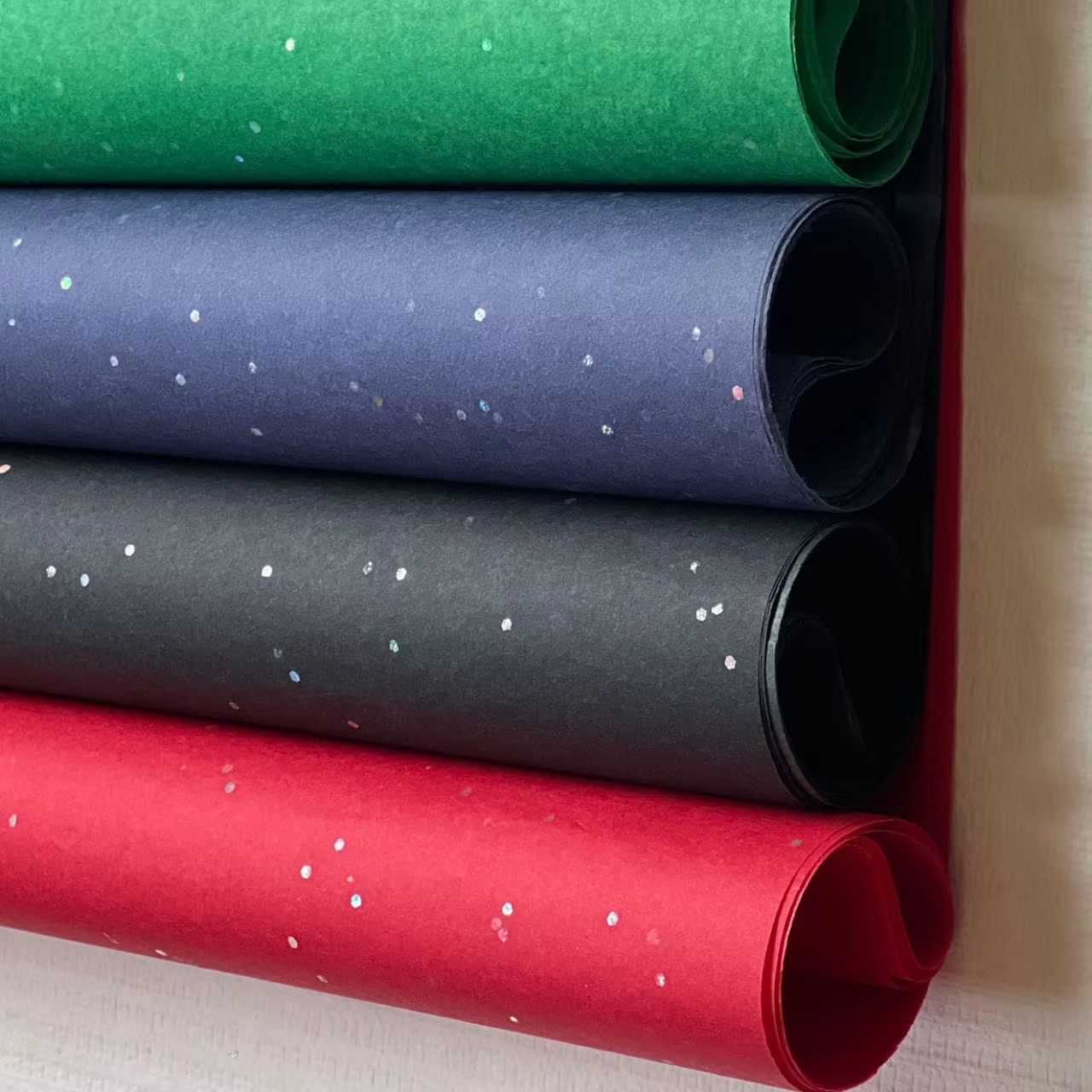Key Factors to Consider When Working with a Colored Tissue Paper Manufacturer
Design Customization and Brand Color Matching Options

Importance of Brand Color Matching in Tissue Paper Customization
When brands get their colors just right on tissue paper, it goes beyond mere function and becomes something memorable. Most top producers rely on Pantone's color system to hit those exact shades, getting almost perfect matches across different materials. Why does this matter so much? Well, according to recent research, around three out of four shoppers link consistent brand colors with professional quality work. Take one beauty company for example they boosted their social media engagement by nearly half when they matched their special teal tissue paper to their product packaging using Pantone standards. The right colors really do make all the difference in how people perceive a brand these days.
Custom Tissue Paper with Logo for Enhanced Brand Identity
Brands often apply logos and designs through methods such as hot foil stamping or digital printing, which helps boost brand awareness and makes products seem more valuable. Take a high-end candle brand as an example they've started putting embossed gold logos onto dark tissue paper. This not only reinforces their upscale image but also cuts down on packaging waste somehow around 15 percent according to their latest reports. The reason? Customers keep coming back because they recognize the brand so well from previous purchases, creating this cycle where strong branding actually leads to less environmental impact over time.
Printed Tissue Paper for Branding and Customization Trends
Minimalist geometric patterns have surged in popularity, increasing 65% year-over-year, alongside demand for eco-conscious water-based inks. Suppliers now offer dual-color sheets and seasonal designs such as frosted holly prints for holiday campaigns, often delivering them 20% faster than industry averages.
Range of Colors and Sizes in Tissue Paper Offerings
| Category | Standard Options | Custom Solutions |
|---|---|---|
| Colors | 50+ stock hues | Full PMS spectrum |
| Sheet Sizes | 12"x12", 20"x20" | Die-cut shapes |
| Pattern Scales | 1"-3" repeats | Micro-printing |
Manufacturer’s Product Range and Customization Flexibility
Top manufacturers combine extensive material inventories—offering over 30 paper textures—with modular production systems. This allows flexibility for small-batch orders starting at 500 sheets up to large-scale runs exceeding 100,000 units, enabling emerging brands to test designs affordably before scaling.
Material Quality, GSM, and Performance Characteristics
Understanding Tissue Paper GSM (Grams Per Square Meter) and Thickness
GSM (grams per square meter) defines tissue paper density and performance. Heavier weights (25–35gsm) provide durability ideal for luxury or reusable gift wraps, while lighter options (15–20gsm) suit delicate applications. According to a 2024 Material Performance Report, papers above 30gsm resist tearing 40% better than standard grades.
Balancing Softness and Strength in Colored Tissue Paper
High-quality colored tissue achieves an optimal balance between tactile softness and structural integrity, typically within the 22–28gsm range. This ensures vibrant dye adhesion without sacrificing the crinkled texture customers expect, making it suitable for both aesthetic appeal and protective packaging functions.
Durability Across Packaging and Gifting Applications
Durability varies by application:
- Retail packaging: 28–35gsm withstands repeated folding and stacking
- Wedding favors: 20–25gsm provides lightweight elegance
- Subscription boxes: Laminated tissues (30gsm+) prevent ink transfer during transit
Premium options retain color saturation through five or more handling cycles, verified through accelerated wear testing.
Printing Precision and Color Accuracy in Production
Evaluating Printing Quality for Vibrant, Long-Lasting Results
Top manufacturers ensure print consistency using spectrophotometers to verify colors against PMS standards, guaranteeing brand fidelity across batches. The 2024 Brand Packaging Report reveals that 78% of luxury brands require physical proofs before approval, underscoring the importance of real-world validation in high-end branding.
Advanced Printing Techniques for Custom Tissue Paper Designs
Hybrid flexographic-digital printing systems enable intricate details and cost-effective production. These support metallic foils and gradient effects once considered unachievable on tissue. Manufacturers using automated pre-press tools reduce color errors by 63% compared to manual methods, based on 2023 graphic arts data.
Ensuring Color Consistency Across Large Production Batches
Consistent output relies on tightly controlled environments—humidity maintained within ±2% tolerance—and ISO-certified ink mixing. Real-time optical sensors detect deviations beyond ΔE<2.0 thresholds, allowing immediate corrections. This precision maintains less than 5% color variance even in orders exceeding 50,000 units.
Sustainability Practices and Eco-Friendly Certifications
Use of Eco-Friendly Materials in Colored Tissue Paper Manufacturing
Leading producers now use recycled cellulose fibers and vegetable-based dyes, reducing reliance on petroleum-based colorants. Over 58% of converters report rising demand for FSC-certified papers, which ensure responsible forestry. These sustainable materials deliver comparable chromatic intensity and biodegrade 30% faster than conventional alternatives.
FSC, Compostable, and Acid-Free Certifications Explained
Third-party certifications validate environmental claims:
- FSC: Traces wood pulp back to sustainably managed forests
- Compostable: Meets ASTM D6400 for full decomposition within 180 days
- Acid-Free: Maintains neutral pH, preventing long-term degradation
Brands using certified materials report 19% higher customer retention, according to a 2023 packaging survey.
Meeting Consumer Demand for Sustainable Packaging Solutions
Seventy-two percent of B2B buyers require suppliers to hold at least one recognized eco-certification, driving adoption of chlorine-free processing and water-based inks. This shift aligns with global regulations phasing out single-use plastics in retail packaging.
Case Study: Brands Shifting to Green Packaging via Sustainable Tissue Suppliers
A premium skincare brand reduced packaging waste by 58% by partnering with a tissue supplier using FSC-certified bamboo fibers. Switching to algae-derived dyes and solar-powered manufacturing contributed to a 31% revenue increase in eco-focused markets within 18 months.
Scalability, Lead Times, and Cost Efficiency
Assessing Production Capacity of a Colored Tissue Paper Manufacturer
Manufacturers with modular systems can scale output by 30–50% during peak seasons without compromising quality. Facilities using automated cutting and folding lines reduce waste by 22% compared to manual operations, according to a 2024 Manufacturing Scalability Report.
Managing Lead Times for Custom Tissue Paper Orders
Lead times average 4–8 weeks depending on design complexity and volume. In-house printing capabilities typically shorten turnaround by 15–20 days versus outsourcing models.
Transparent Pricing Models and Minimum Order Requirements
Tiered pricing structures commonly reduce costs by 8–12% for orders over 10,000 units. While standard MOQs start around 5,000 sheets, smaller batches (1,000–3,000 units) now represent 37% of specialty packaging demand.
Impact of MOQs on Small and Mid-Sized Business Partnerships
Although bulk orders offer savings, 62% of startups favor suppliers with flexible MOQs. Hybrid production models—using digital printing for small runs and rotary presses for large volumes—enable consistent branding across product launches regardless of scale.










